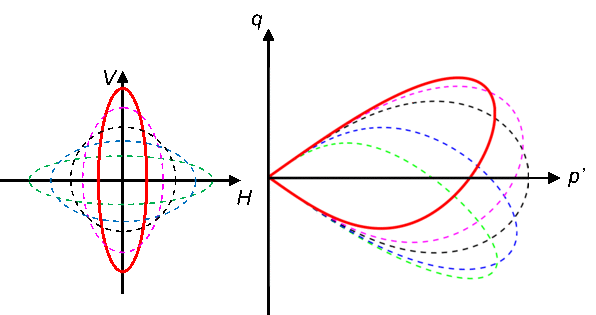Fabric-enriched damage mechanics
General rules that would allow one to connect continuum behavior to the micro-scale features (e.g., the geometry of cracks, pores, and grains) are of great significance in geomechanics. Our goal is to propose a fabric-enriched damage mechanics framework to understand the damage accumulation in geomaterials. Uniaxial consolidation tests and cyclic compression tests were conducted on reagent-grade granular salt in dry conditions at 150 C. 2D-microscopic images, parallel to the axis of loading, were obtained at several stages of tests. Microstructure image analyses were performed to obtain probability density functions (PDFs) of the area, solidity, coordination number, orientation, elongation and roundness of the grains, as well as the PDFs of the branch lengths, branch orientations and solid volume fraction, defined locally over polygons with edges matching grain centroids. The Discrete Wing Crack Elastoplastic Damage (DWCPD) Model was proposed based on the microscopic observations to characterize the initiation and propagation of microcracks in the polycrystalline materials. Fabric tensors are going to be calculated to assess microstructure anisotropy and its effects on the stiffness tensors.

Breakage process in granular materials
Our research focuses on the effect of microscopic grain-scale processes on the deformation of anisotropic geological solids, as well as their interaction with pore fluids. Our goal is to expand the current understanding of how the granular systems behave under extreme pressure conditions. A fabric tensor was introduced in the expression of Helmholtz free energy to characterize the anisotropic elasticity and anisotropic yielding of granular media within the framework of breakage mechanics. The effects of relative humidity on the breakage and damage processes of cemented granular materials. A continuum breakage-damage model for high-porosity granular rocks has been formulated by incorporating moisture effects on the strength of the grains, as well as on the brittle cement bonds bridging them.


Homogenization scheme for pressure-solution driven healing
Pressure solution is a very effective healing mechanism, common in crystalline media. Our goal is to understand the chemical effects (i.e., pressure solution) on the deformation and mechanical properties of rock. Chemomechanical homogenization models were formulated to predict the long term healing process in geomaterials. Pressure solution induces geometric changes, which were used to calculate the viscous strain rate of the inclusion. Homogenization schemes (i.e., Hill’s inclusion-matrix interaction law and Mori-Tanaka method) were used to upscale strains and stresses at the scale of a Representative Elementary Volume (REV), so as to capture the creep, hysteresis rate-dependent behavior of salt rock.

Multi-scale analysis on granite bedrock weathering
Bedrock weakening is of wide interest because it influences landscape evolution, chemical weathering, and subsurface hydrology. A longstanding hypothesis states that bedrock weakening is driven by chemical weathering of minerals like biotite, which expand as they weather and create stresses sufficient to fracture rock. Here we build on recent advances in rock damage mechanics to develop a model for the influence of multi-mineral chemical weathering on bedrock damage, which is defined as the reduction in bedrock stiffness. We use biotite chemical weathering as an example application of this model to explore how the abundance, aspect ratio, and orientation affect the time-dependent evolution of bedrock damage during biotite chemical weathering.

Computational modeling of long-term thermo-hydraulic behavior of frozen soil
Permafrost, a geomaterial class consisting of permanently frozen soils and covering almost a quarter of the northern hemisphere onshore land, is known to be highly sensitive to climate change. We will formulate a constitutive model to predict the dynamic interactions between the plastic response of frozen soil, phase transition of water, and interfacial effects in frozen soil under changing loading conditions. Changes in capillary pressure can induce expansion and/or shrinkage of the solid skeleton, and the deformation of the solid skeleton can further alter the permeability of frozen soil. Similar to unsaturated soils, frozen porous media exhibit transitions in behavior due to interfacial effects. Thermal effects will also be introduced into our modeling framework, thus enabling the examination of phase transitions and their impact on the fabric of solids and interfacial effects.